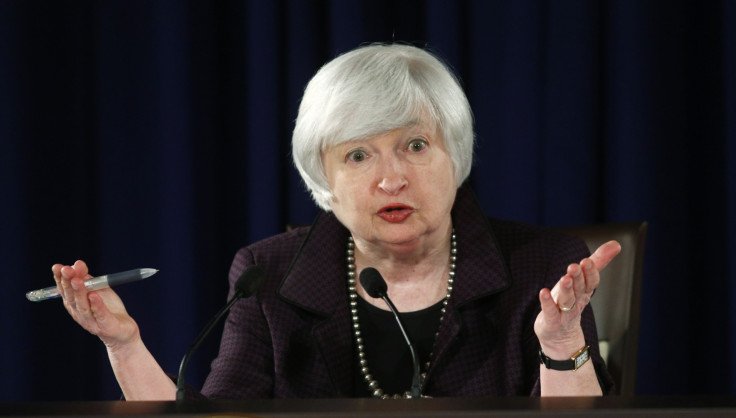Federal Reserve System: 3 Things To Watch From FOMC Meeting

Economists will get a glimpse into the overall health of the U.S. economy Wednesday, as the U.S. Federal Reserve prepares to release a statement following the Federal Open Market Committee's first two-day policy meeting of the year. Market professionals will analyze the statement, looking for clues as to when the central bank plans to raise interest rates and how deflationary concerns and the dramatic decline in oil prices could alter the Fed’s monetary policy decisions in 2015.
Major global economies, including Europe and Asia, are showing signs of weakness, and economists fear that a slowdown in global growth will impact the U.S. economy. “The U.S. economy is very strong and is still the best game in town, but the U.S. economy alone can’t carry global growth," Jeff Kravetz, regional investment director at U.S. Bank Wealth Management, said.
The Fed kept the phrase "considerable time" in its previous policy statement in December, but introduced a new phrase "patient," hinting the central bank could raise interest rates sometime this year.
Below is a more in-depth look at what economists will be monitoring from the FOMC’s statement.
1. Interest Rates
Most economists expect the central bank to hike interest rates in mid-2015, but if falling oil prices have a negative effect on an improving U.S. economy, weighing on inflation and wage growth, the Fed could pause before raising rates.
Last week, the European Central Bank announced further monetary stimulus measures to aid the troubled eurozone, which faces mounting deflationary fears as the area nears a triple-dip recession. But in a surprise move earlier this month, the Swiss National Bank shocked financial markets by abandoning a three-year-old cap on the Swiss franc. The move sent the currency soaring more than 41 percent, while Swiss stocks plunged more than 10 percent following the announcement.
The Reserve Bank of India also surprised the global financial markets in January after the central bank slashed interest rates, the first rate cut since March 2013, in an attempt to spur growth in Asia's third-largest economy.
“These factors are definitely going to be considered by the Fed. I think what it does to the Fed is that it makes them a little more cautious and patient on raising rates,” Kravetz said.
2. Inflation
Inflation continues to run below the central bank’s 2 percent target, as it has for more than 30 consecutive months. Data last month showed the price index for personal consumption expenditures, the central bank’s preferred measure for inflation, declined 0.2 percent in November from the previous month and increased 1.2 percent from a year earlier, the Commerce Department said on Dec. 23. Meanwhile, the Core PCE remained flat in November at 1.4 percent from a year earlier. Because inflation remains below the Fed’s target, most economists don’t expect it to raise rates before the middle of 2015. As inflation begins to cool, the next cause for concern for economists is "nightmare" deflation.
“Deflation is a nightmare, and it’s difficult to cure,” Peter Cardillo, chief market economist at Rockwell Global Capital, said to International Business Times earlier this month.
Minneapolis Fed President Narayana Kocherlakota and other economists wrote in a recent paper that there’s an increasing possibility that deflation could creep into the U.S. economy. As oil prices have tumbled more than 40 percent since June to lows not seen since the Great Recession, Kocherlakota and the paper’s other authors fear the global markets are on the cusp of a fearsome deflation.
“I don’t think there’s as much worry about deflation in the U.S.,” Jeff Kravetz, regional investment director at U.S. Bank Wealth Management, said. The bigger concern is deflation throughout the global economy. “The worry about deflation is more in Europe and downward pressure on commodity producing countries throughout the world,” Kravetz said.
3. Declining Oil Prices
The Fed warned earlier this month in its “Beige Book,” a report the central bank publishes eight times a year, that plunging oil prices since June are beginning to show harmful effects in U.S. regions that are dependent upon the energy industry, causing oil firms to report layoffs and hiring freezes.
Oil drilling activity declined in the Fed’s Kansas City district, while the report showed high stockpile levels in crude across the Gulf Coast, a cause for concern for oversupply and less demand.
“The game has really changed globally. It’s a different story globally than it was a year ago. With oil prices significantly down to the tune of 50 percent, it's definitely putting downward pressure on inflation, not only here but in Europe and throughout the rest of the world,” Kravetz said.
During a press conference following the policy meeting in December, however, Fed Chair Janet Yellen said the central bank expects inflation impacts from declining oil prices will be “transitory” and "will likely hold down overall inflation in the near term," adding that "as oil price declines and other transitory factors dissipate," the Fed expects inflation to move back toward its 2 percent target.
The FOMC will release a statement Wednesday at 2 p.m. EST following the Fed's two-day meeting.
© Copyright IBTimes 2024. All rights reserved.






















